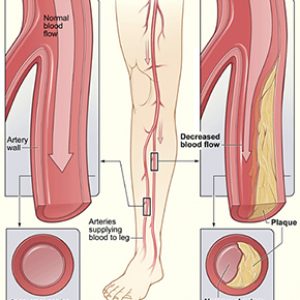Peripheral Artery Disease or Peripheral vascular disease (PVD) is a slow-growing circulation disorder.
Peripheral artery disease is most often caused by an accumulation of fatty deposits in the arteries. Peripheral artery disease is a major risk factor which causes heart attack and stroke. Peripheral artery disease is a form of arterial insufficiency, means blood flowing(circulation) through the arteries (i.e. blood vessels that carry blood away from the heart) is decreased. Some people over the age of 50 are believed to suffer from peripheral artery disease. Men are most likely to develop PAD than women. People who smoke are most likely to develop Peripheral artery disease.
Other names that have been used to denote Peripheral vascular disease include:
- Atherosclerotic peripheral artery disease
- Hardening of the arteries
- Peripheral artery disease
- Poor circulation
- Vascular disease
- PAD
Surroundings related to PVD that affect the veins include Deep Vein Thrombosis (DVT), varicose veins, and chronic venous insufficiency. Lymphedema is also a clear example of Peripheral Vascular Disease which affects the lymphatic vessels. When PVD occurs in the arteries outside of the heart, it can also be referred to as Peripheral Arterial Disease (PAD).

Symptoms and signs of peripheral artery disease include:
- Numbness of the legs or feet.
- Weakness, diminished size and strength of the calf muscle.
- Coldness in the legs or feet.
- Changes in the color of the feet; feet turn pale when they are elevated, and turn dusky red in the dependent position.
- Hair loss and thickening of the toenails.
- Poor wound healing in the legs or feet.
- Painful ulcers, gangrene in areas of the feet where blood supply is lost(typically in the toes).
Risk for peripheral artery disease :
- High blood levels of the cholesterol and triglycerides
- Low blood levels of the “good” HDL cholesterol
- Cigarette smoking
- Diabetes mellitus (both type 1 and type 2 diabetes)
- High blood pressure (hypertension, tension, mental stress) or a family history of hypertension
- A family history of atherosclerotic disease
- Chronic renal failure
- Overweight or obesity
How is peripheral artery disease diagnosed?
Doppler ultrasound – It is a form of ultrasound (measurement of high-frequency sound waves that are reflected off of tissues) that can detect and measure blood flow. It is used to measure blood pressures behind the knees and at the ankles.
Duplex ultrasound – Is a color assisted non-invasive technique to study the arteries. Ultrasound probes are placed on the skin overlying the arteries which can accurately detect the accurate position of artery stenosis as well as measure the degree of obstruction.
Angiography – It is an imaging procedure to study the blood vessels of the extremities, similar to the way a coronary angiogram provides an image of the blood vessels supplying the heart. It is the most accurate test to detect the location(s) and severity of artery obstructions, as well as collateral circulations.
Magnetic resonance imaging (MRI) angiography uses magnetism, radio waves, and a computer to produce images of body structures and has the advantage of avoiding X-ray radiation exposure.
Computed tomographic angiography (CT) – It is another non-invasive test that images the arteries of a patient’s abdomen, pelvis, and legs. This test is specifically useful in patients with pacemakers or stents.
Treatment of peripheral artery disease includes
- Terminating Smoking eliminates a major risk factor for diseases to progress, and it lowers the incidences of pain at rest and amputations. Controlling Smoking also is important to prevent heart attacks and strokes.
- A healthy diet can help lower blood cholesterol and other lipid levels and may also help control blood pressure.
- Keep other risk factors, such as diabetes, lipid levels, and blood pressure under control by changing your diets, regular exercise, meditation.
Medications:
- Antiplatelet medications
- Anticoagulant medications
- Cholesterol-lowering drugs
- Cilostazol (Pletal)
- Pentoxifylline (Pentoxyl, Trental)
- Drugs to control hypertension
Dr. Advait Kothurkar is a Vascular Surgeon in Pune. With one of the largest Peripheral Vascular Surgical and Endovascular experience in the country, treating thousands of patients with vascular disease, Dr. Kothurkar offers balanced patient care with an emphasis on minimally invasive therapies. Under the leadership of Dr. Kothurkar, Pune’s most respected figure in vascular surgery nationally & internationally. Consult Dr. Advait Kothurkar for the treatment of Peripheral Artery Disease.
